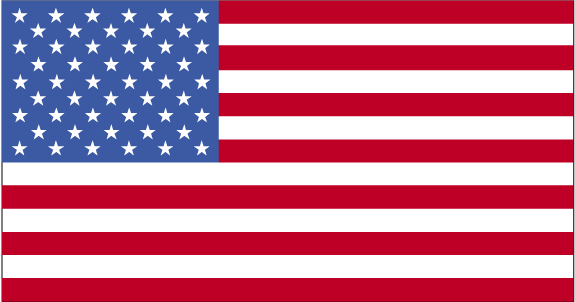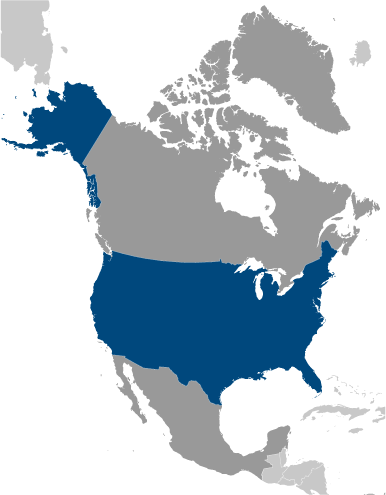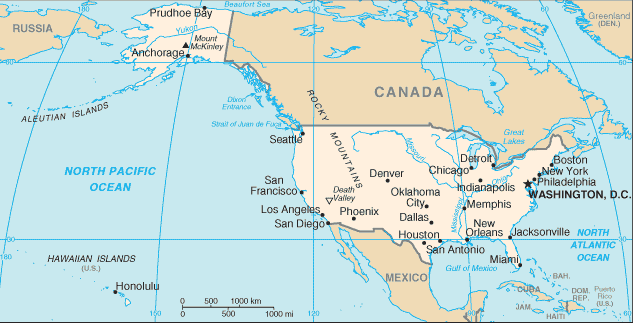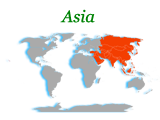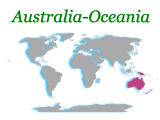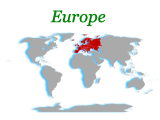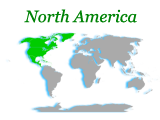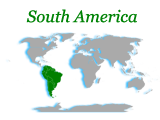Britain's American colonies broke with the mother country in 1776 and were recognized as the new nation of the United States of America following the Treaty of Paris in 1783. During the 19th and 20th centuries, 37 new states were added to the original 13 as the nation expanded across the North American continent and acquired a number of overseas possessions. The two most traumatic experiences in the nation's history were the Civil War (1861-65), in which a northern Union of states defeated a secessionist Confederacy of 11 southern slave states, and the Great Depression of the 1930s, an economic downturn during which about a quarter of the labor force lost its jobs. Buoyed by victories in World Wars I and II and the end of the Cold War in 1991, the US remains the world's most powerful nation state. Over a span of more than five decades, the economy has achieved steady growth, low unemployment and inflation, and rapid advances in technology.
Population
310,232,863 (July 2010 est.)
Country comparison to the world:3
Nationality
Noun:American(s)
Adjective:American
Ethnic groups
white 79.96%, black 12.85%, Asian 4.43%, Amerindian and Alaska native 0.97%, native Hawaiian and other Pacific islander 0.18%, two or more races 1.61% (July 2007 estimate)
note: a separate listing for Hispanic is not included because the US Census Bureau considers Hispanic to mean persons of Spanish/Hispanic/Latino origin including those of Mexican, Cuban, Puerto Rican, Dominican Republic, Spanish, and Central or South American origin living in the US who may be of any race or ethnic group (white, black, Asian, etc.); about 15.1% of the total US population is Hispanic
Religions
Protestant 51.3%, Roman Catholic 23.9%, Mormon 1.7%, other Christian 1.6%, Jewish 1.7%, Buddhist 0.7%, Muslim 0.6%, other or unspecified 2.5%, unaffiliated 12.1%, none 4% (2007 est.)
Languages
English 82.1%, Spanish 10.7%, other Indo-European 3.8%, Asian and Pacific island 2.7%, other 0.7% (2000 census)
note: Hawaiian is an official language in the state of Hawaii
Country Name
Conventional long form:United States of America
Conventional short form:United States
abbreviation: US or USA
Government Type
Constitution-based federal republic; strong democratic tradition
Capital
Name:Washington, DC
Geographic coordinates:38 53 N, 77 02 W
Time difference:UTC-5 (during Standard Time)
daylight saving time: +1hr, begins second Sunday in March; ends first Sunday in November
note: the 50 United States cover six time zones
Administrative divisions
50 states and 1 district*; Alabama, Alaska, Arizona, Arkansas, California, Colorado, Connecticut, Delaware, District of Columbia*, Florida, Georgia, Hawaii, Idaho, Illinois, Indiana, Iowa, Kansas, Kentucky, Louisiana, Maine, Maryland, Massachusetts, Michigan, Minnesota, Mississippi, Missouri, Montana, Nebraska, Nevada, New Hampshire, New Jersey, New Mexico, New York, North Carolina, North Dakota, Ohio, Oklahoma, Oregon, Pennsylvania, Rhode Island, South Carolina, South Dakota, Tennessee, Texas, Utah, Vermont, Virginia, Washington, West Virginia, Wisconsin, Wyoming
Independence
4 July 1776 (from Great Britain)
National Holiday
Independence Day, 4 July (1776)
Constitution
17 September 1787, effective 4 March 1789
Legal system
federal court system based on English common law; each state has its own unique legal system of which all but one (Louisiana, which is still influenced by the Napoleonic Code) is based on English common law; judicial review of legislative acts; has not accepted compulsory ICJ jurisdiction
Suffrage
18 years of age; universal
Executive branch
Chief of state:President Barack H. OBAMA (since 20 January 2009); Vice President Joseph R. BIDEN (since 20 January 2009); note - the president is both the chief of state and head of government
Head of government:President Barack H. OBAMA (since 20 January 2009); Vice President Joseph BIDEN (since 20 January 2009)
Cabinet:Cabinet appointed by the president with Senate approval
(For more information visit the World Leaders website)
Elections: president and vice president elected on the same ticket by a college of representatives who are elected directly from each state; president and vice president serve four-year terms (eligible for a second term); election last held 4 November 2008 (next to be held on 6 November 2012)
Election results:Barack H. OBAMA elected president; percent of popular vote - Barack H. OBAMA 52.4%, John MCCAIN 46.3%, other 1.3%;
Legislative branch
bicameral Congress consists of the Senate (100 seats, 2 members elected from each state by popular vote to serve six-year terms; one-third elected every two years) and the House of Representatives (435 seats; members directly elected by popular vote to serve two-year terms)
Elections:Senate - last held on 4 November 2008 (next to be held in November 2010); House of Representatives - last held on 4 November 2008 (next to be held in November 2010)
Election results:Senate - percent of vote by party - NA; seats by party - Democratic Party 57, Republican Party 41, independent 2; House of Representatives - percent of vote by party - NA; seats by party - Democratic Party 257, Republican Party 178
Judicial branch
Supreme Court (nine justices; nominated by the president and confirmed with the advice and consent of the Senate; appointed to serve for life); United States Courts of Appeal; United States District Courts; State and County Courts
Political Parties and Leaders
Democratic Party [Timothy KAINE]; Green Party; Libertarian Party [William (Bill) REDPATH]; Republican Party [Michael STEELE]
Political pressure groups and leaders
environmentalists; business groups; labor unions; churches; ethnic groups; political action committees or PAC; health groups; education groups; civic groups; youth groups; transportation groups; agricultural groups; veterans groups; women's groups; reform lobbies
International organization participation
ADB (nonregional member), AfDB (nonregional member), ANZUS, APEC, Arctic Council, ARF, ASEAN (dialogue partner), Australia Group, BIS, BSEC (observer), CBSS (observer), CD, CE (observer), CERN (observer), CICA (observer), CP, EAPC, EBRD, FAO, FATF, G-20, G-5, G-7, G-8, G-10, IADB, IAEA, IBRD, ICAO, ICC, ICCt (signatory), ICRM, IDA, IEA, IFAD, IFC, IFRCS, IHO, ILO, IMF, IMO, IMSO, Interpol, IOC, IOM, ISO, ITSO, ITU, ITUC, MIGA, MINUSTAH, NAFTA, NATO, NEA, NSG, OAS, OECD, OPCW, OSCE, Paris Club, PCA, PIF (partner), SAARC (observer), SECI (observer), SPC, UN, UN Security Council, UNCTAD, UNESCO, UNHCR, UNITAR, UNMIL, UNRWA, UNTSO, UPU, WCO, WFTU, WHO, WIPO, WMO, WTO, ZC
Flag description
13 equal horizontal stripes of red (top and bottom) alternating with white; there is a blue rectangle in the upper hoist-side corner bearing 50 small, white, five-pointed stars arranged in nine offset horizontal rows of six stars (top and bottom) alternating with rows of five stars; the 50 stars represent the 50 states, the 13 stripes represent the 13 original colonies; known as Old Glory
note: the design and colors have been the basis for a number of other flags, including Chile, Liberia, Malaysia, and Puerto Rico
